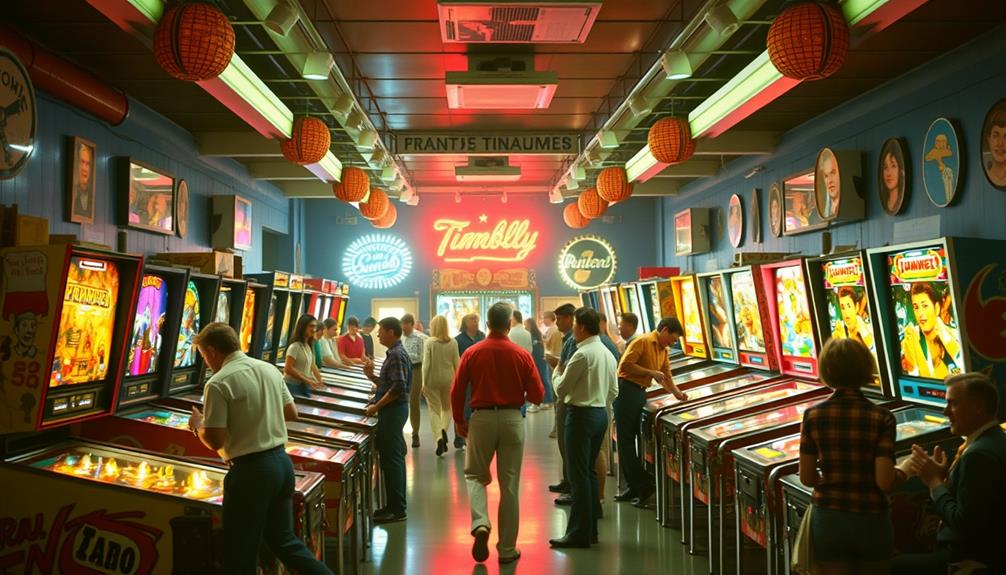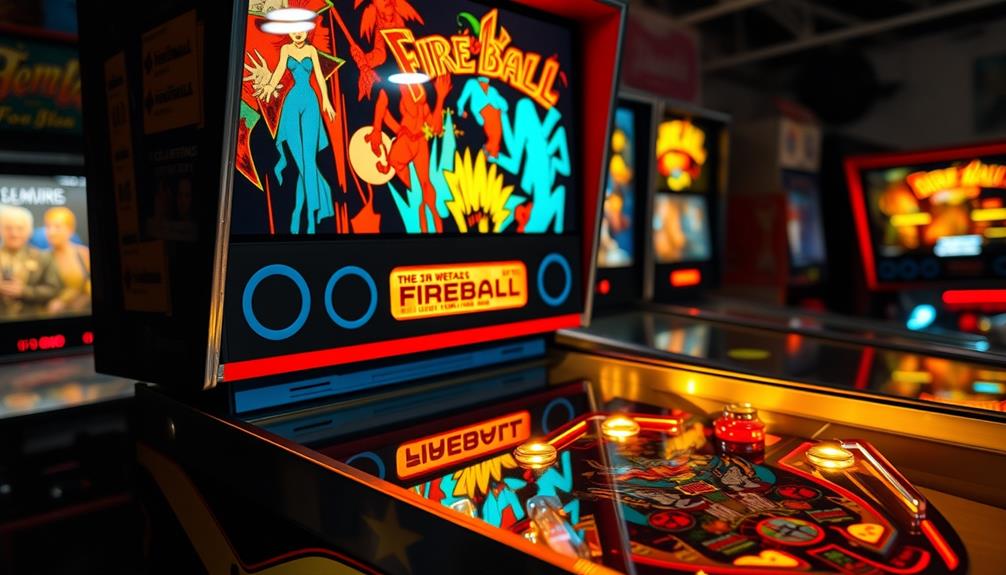Pinball machines became extremely popular from the 1930s to the mid-1950s. This period, often known as the Golden Age of Pinball, witnessed machines becoming fixtures in bars, candy stores, and amusement centers. Players were attracted to these games because of their skill-based gameplay and competitive social aspect. Despite facing a significant decline during World War II due to production challenges, pinball saw another decrease in the 1980s with the emergence of video games. However, its appeal has endured, leading to a revival in the 2000s. Stay tuned to discover the ups and downs of pinball’s fascinating history!
Key Takeaways
- Pinball machines gained popularity in the 1930s, becoming common in social spaces during the Great Depression.
- The Golden Age of Pinball spanned from the early 1930s to the mid-1950s, marked by innovation and widespread appeal.
- Pinball faced a decline in popularity during World War II due to production limitations and bans in some cities.
- The late 1970s and 1980s saw a decline as video games became the preferred entertainment choice among players.
- A resurgence occurred in the 2000s, driven by retro gaming trends and competitive events that revitalized interest in pinball.
Origins of Pinball Machines
Pinball machines trace their origins back to the early 19th century with the invention of bagatelle tables, where players aimed to hit balls into scoring pockets. These early games set the stage for what would evolve into modern pinball machines.
In 1871, Montague Redgrave patented an improved version of bagatelle, introducing features like a coiled spring and plunger mechanism. This innovation greatly influenced the design of future pinball machines. The concept of investment in entertainment technology began to flourish during this period, as manufacturers sought to enhance gameplay and attract players.
By the 1930s, the first true coin-operated pinball machine emerged, revolutionizing how people engaged with the game. Bally Manufacturing Corporation produced notable models like Ballyhoo, which quickly gained popularity in amusement venues.
The term "pinball" was officially coined in 1936, marking an important moment in the history of pinball as it began to carve out its identity separate from bagatelle.
The Rise in Popularity
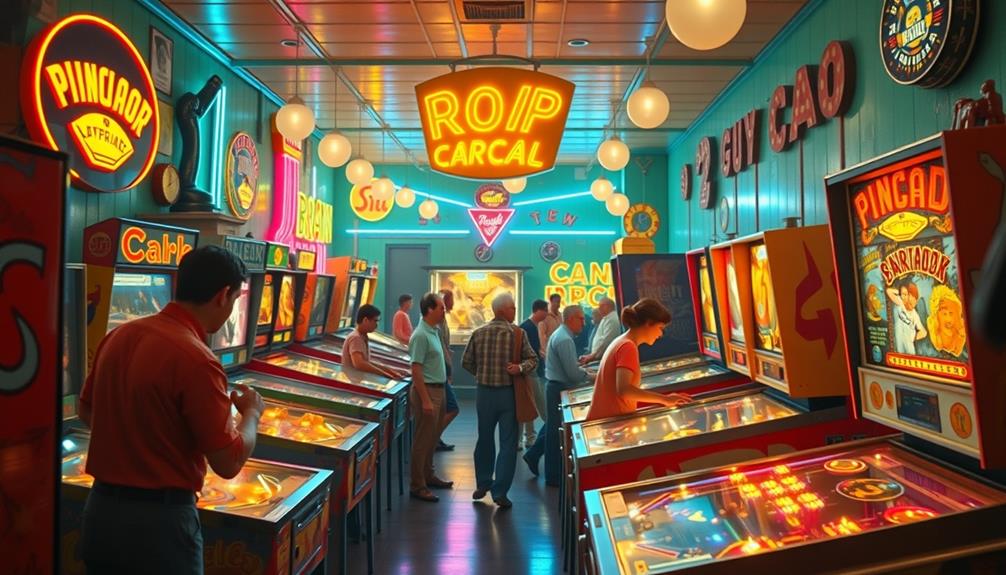
As you explore the rise in popularity of pinball machines, you'll notice how coin-operated models surged in the 1930s, making them a common sight in social spaces like candy stores and bars. The history of pinball machines also saw a boom in the 1970s with the introduction of electronic features and sound effects, further increasing their appeal. However, in the 1980s, pinball machines faced competition from video games and saw a decline in popularity. Despite this, pinball machines have made a comeback in recent years, with many enthusiasts collecting vintage models and new machines being produced with modern technology. The history of pinball machines is closely tied to the evolution of entertainment and gaming culture. Today, the history of pinball machines continues to be celebrated through pinball museums and tournaments, showcasing the evolution of the game and its cultural impact. The history of pinball machines is a fascinating reflection of societal trends and technological advancements, with each era bringing new innovations and challenges for the game. Whether it’s the classic charm of vintage models or the cutting-edge features of modern machines, the history of pinball machines remains a beloved and enduring part of gaming history.
The nostalgia associated with games of skill, much like the cultural impact of Star Wars franchise, contributed to their allure.
The introduction of competitive play added excitement, drawing in crowds enthusiastic to test their skills against each other.
This combination turned pinball into not just a game, but a vibrant part of community life.
Coin-Operated Machines Surge
Surging in popularity during the 1930s, coin-operated pinball machines quickly became a beloved fixture in candy stores, bars, and amusement centers across America. The introduction of Ballyhoo by Bally Manufacturing Corporation in 1931 marked a pivotal moment, establishing one of the first successful coin-operated pinball machines.
This era also saw a rise in unique party options that capitalized on the social ambiance created by such games, enhancing gatherings and celebrations.
Pinball not only provided affordable entertainment during the Great Depression but also attracted a wide range of players. By the 1950s, the U.S. boasted around 15,000 operational machines, a demonstration of its growing appeal.
Here are a few reasons why pinball gained such popularity:
- Accessibility: With low costs, anyone could enjoy a game without breaking the bank.
- Social Experience: Pinball brought people together, creating a lively atmosphere in amusement centers and bars.
- Skill-Based Gameplay: The emergence of competitive models encouraged players to hone their skills and engage in friendly rivalry.
As you can see, the rise of coin-operated pinball machines transformed leisure time, making it a staple in American culture. Their charm and accessibility guaranteed their place in the hearts of many.
Competitive Play Attraction
With the introduction of competitive models like Gottlieb's Baffle Ball and Bally's Ballyhoo, pinball quickly evolved into a thrilling contest of skill. As the game shifted from a mere game of chance to one heavily reliant on player skill, the excitement surrounding competitive play surged.
This evolution mirrors the growing interest in various competitive gaming formats, such as top projectors for gaming enthusiasts, which enhance the overall experience. You could see this change reflected in the growing popularity of pinball tournaments and leagues that began to emerge in the 1970s. Players started honing their abilities, aiming for high scores and pushing each other to improve.
The introduction of player-controlled flippers in 1947 was a game-changer, allowing you to directly influence the outcome and enhancing the competitive nature of pinball. This transformation not only attracted seasoned gamers but also invited newcomers into the pinball community, enthusiastic to test their skills against others.
In recent years, the resurgence of pinball has been largely fueled by an increase in competitive events, drawing in a diverse crowd of enthusiasts. As more players embrace the challenges of gameplay, the competitive spirit continues to elevate the popularity of pinball, solidifying its place in both nostalgic and modern gaming culture.
Social Gathering Spaces
The rise of pinball machines as social gathering spaces greatly contributed to their popularity during the 1930s and 1940s. These machines became a staple in candy stores, bars, and amusement centers, drawing people in with their engaging gameplay and inviting atmosphere.
As a low-cost entertainment option during the Great Depression, pinball flourished, allowing friends and families to connect and bond over a shared experience. In many ways, the communal aspect of pinball mirrored the appeal of New England camping locations, where individuals come together to enjoy nature and create lasting memories.
Pinball machines served as gathering points where you could:
- Engage in friendly competition, making each game an exciting challenge.
- Enjoy a casual night out with friends, bringing together diverse groups of people.
- Foster camaraderie and community spirit, as players cheered each other on.
The social aspect of pinball was key to its appeal. The introduction of competitive models and tournaments only heightened this dynamic, attracting even larger crowds.
As you played, you weren't just focused on the game; you were part of a vibrant community, sharing laughs and celebrating victories together. This sense of togetherness solidified pinball's status as a beloved form of entertainment, making it an essential part of social life during that era.
Golden Age of Pinball
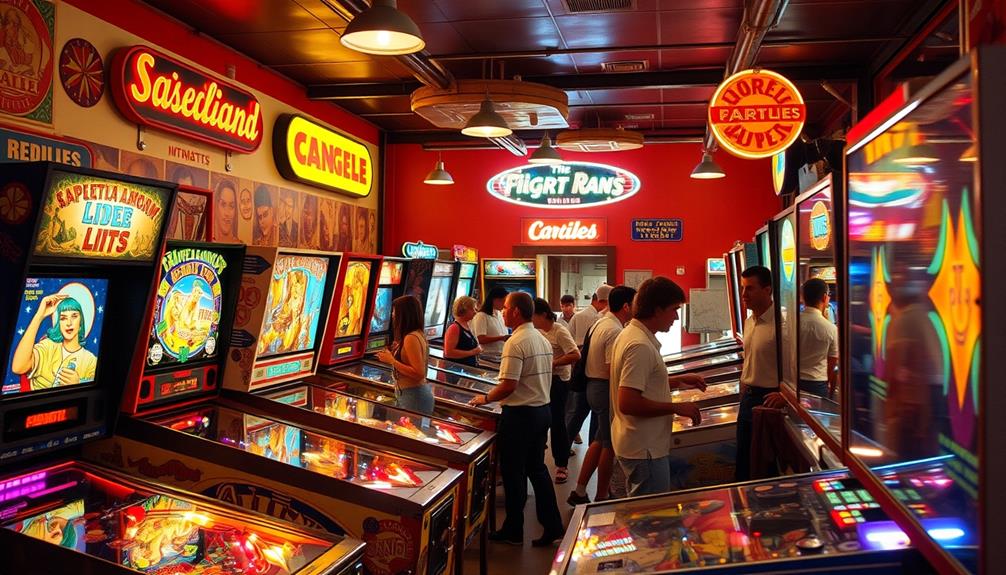
You might be surprised to learn that the Golden Age of Pinball, spanning from the early 1930s to the mid-1950s, marked a turning point in the game's history.
With the introduction of the flipper in 1947, pinball machines became more than just luck-based games; they transformed into skill-driven entertainment that captivated audiences.
This era not only saw technological innovations but also solidified pinball's cultural significance in American society.
Origins in the 1930s
Emerging from the shadows of the Great Depression, pinball machines quickly became a beloved form of entertainment in America during the 1930s. This era marked the beginning of the pinball revolution, with the release of Ballyhoo in 1931, the first true coin-operated pinball machine developed by Raymond Maloney.
The introduction of these machines offered a low-cost option for fun, helping people escape the harsh realities of the time. The innovative designs and mechanics of the machines were akin to the toilet flushing mechanisms that promote efficiency and user engagement.
During the 1930s, several factors contributed to the popularity of pinball machines:
- The official coining of the term "pinball" in 1936, distinguishing it from earlier games like bagatelle.
- Major manufacturers like Gottlieb, Williams, and Chicago Coin entered the scene, fueling competition and innovation.
- Pinball machines became fixtures in candy stores, bars, and arcades, making them accessible to a wide audience.
Technological Innovations Emerge
During the Golden Age of Pinball, which spanned from the late 1970s to the early 1990s, players experienced a thrilling evolution in gameplay thanks to groundbreaking technological innovations. The introduction of solid-state electronic pinball machines replaced traditional electromechanical games, allowing for more complex gameplay and enhanced scoring systems.
Bally's "Flicker," released in 1974, was a pioneer, becoming the first pinball machine to utilize a microprocessor. This innovation paved the way for advanced game features that captivated players, much like the way AI-powered virtual reality in e-learning enhances interactive experiences.
One of the most exciting developments during this era was multi-ball play, which transformed how you interacted with the game. Suddenly, you could experience intense competition as multiple balls flew around the playfield, challenging your skills and reflexes.
By the mid-1980s, machines began incorporating video modes and LCD screens, elevating the gaming experience even further. Williams' "The Addams Family," released in 1992, became the best-selling pinball machine of all time, showcasing these innovative features.
The shift towards more interactive and theme-based machines not only attracted diverse audiences but also led to a boom in sales, highlighting the cultural significance of this Golden Age in pinball history.
Cultural Impact and Appeal
Transforming into a beloved pastime, the Golden Age of Pinball left an indelible mark on American culture and social life. The era spanned from the 1930s to the early 1950s, during which the pinball industry flourished. The introduction of flippers in 1947 turned pinball into a skill-based game, markedly enhancing its appeal and fostering competitive play.
Initially viewed as gambling devices, pinball machines faced political opposition, but this only fueled their underground allure. During this period, the social aspects of games, including the importance of community engagement and shared experiences, played a vital role in fostering connections among players, akin to the key domains of development observed in childhood growth.
As perceptions shifted, the successful demonstration by Roger Sharpe in 1976 showcased the game's reliance on skill rather than chance, leading to a resurgence in popularity. This era's innovations contributed to pinball's cultural significance as a social and entertainment medium that captivated both adults and children.
Key aspects of this cultural impact include:
- The rise of pinball as a common fixture in bars and arcades.
- The development of diverse themes and electronic scoring, enriching gameplay.
- Pinball tournaments and competitions that fostered community engagement.
Ultimately, the Golden Age of Pinball created a lasting legacy that continues to resonate in today's gaming culture.
Impact of World War II
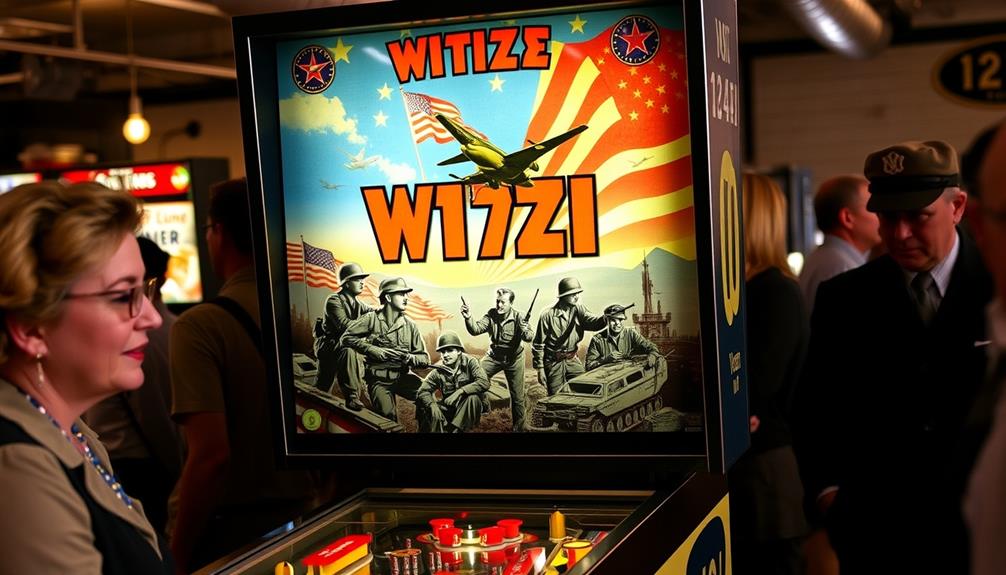
World War II substantially impacted the pinball machine industry, leading to a sharp decline in its popularity. As the war effort ramped up, production resources shifted away from pinball machines, and many arcades closed or were repurposed.
In 1942, a ban on pinball was implemented in New York City, with Mayor Fiorello La Guardia spearheading an anti-pinball campaign. He argued that these machines were gambling devices that exploited vulnerable citizens, which further diminished their presence in public entertainment venues. During this time, the emotional impact of losing such recreational outlets was felt by many, as they sought ways to cope with the growing stress of wartime life and support networks became essential.
The ban, alongside police raids, resulted in the confiscation and public destruction of thousands of pinball machines. This crackdown effectively forced the machines into underground settings, where they persisted despite the negative perception surrounding them.
Though pinball machines faced significant challenges during the war, their resilience shone through. Players sought these games in hidden locations, maintaining a flicker of interest that would later fuel a resurgence after the war.
This period marked a turning point for pinball, demonstrating that even in the face of adversity, the allure of the game remained strong, waiting for the right moment to bounce back into the spotlight.
Decline in the 1980s
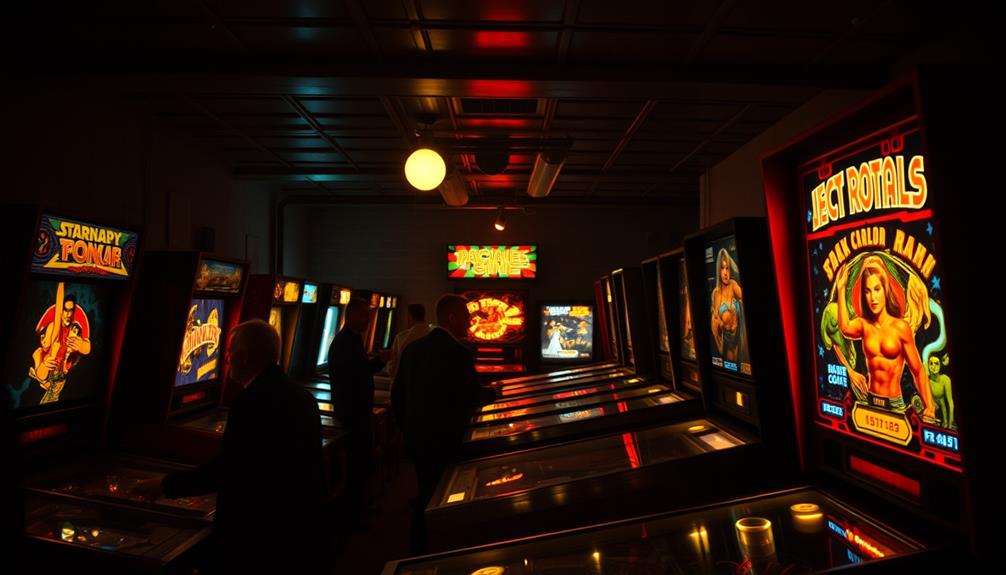
The rise of video games in the late 1970s marked a turning point for pinball machines, as players flocked to the more dynamic and visually engaging arcade experiences.
This shift was reminiscent of the impact of AI-driven platforms that cater to diverse preferences, as players began to seek out more personalized and interactive forms of entertainment.
By the early 1980s, this shift became evident as establishments started phasing out pinball machines in favor of video gaming options. Many viewed video games as more engaging and technologically advanced.
Several factors contributed to the decline of pinball machines during this period:
- Increased Competition: Video games offered fast-paced action and immersive experiences that drew players away.
- Regulatory Challenges: New laws made manufacturing and operating pinball machines more complex and burdensome for operators.
- Cultural Shift: A growing interest in digital gaming among younger audiences led to decreased interest in traditional pinball.
The Digital Transformation

In recent years, pinball machines have embraced a digital transformation that's reinvigorated the classic game. The introduction of microprocessors in the late 1970s marked a significant turning point, allowing for more complex gameplay and features that surpassed earlier electromechanical designs.
Williams' "Hot Tip," released in 1977, pioneered solid-state electronic pinball, leading to advanced scoring systems and improved reliability.
Fast forward to today, and modern machines are equipped with advanced technology like LED lighting, LCD screens, and interactive elements. These innovations enhance the immersive experience, making gameplay more engaging and dynamic.
The first pinball machine to incorporate a video display appeared in 1998, showing how the blend of traditional pinball with digital elements can create a hybrid gaming experience that captivates players.
The rise of the internet has also fostered a vibrant community of enthusiasts and collectors, enabling the buying, selling, and trading of machines like never before.
This digital transformation not only preserves the nostalgia of pinball but also attracts new audiences, ensuring that the game remains relevant and exciting in the modern entertainment landscape.
Resurgence in the 2000s
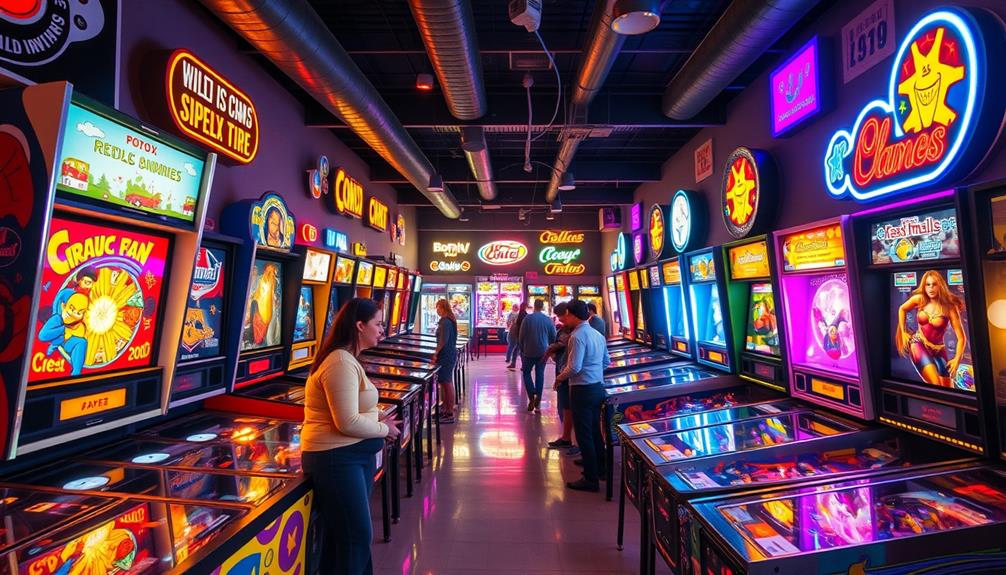
Pinball machines experienced a remarkable resurgence in the 2000s, fueled by a growing passion for retro gaming and a desire for tactile experiences. This revival attracted both new players and long-time enthusiasts who cherished the mechanical gameplay.
The decade saw considerable developments that redefined the landscape of pinball.
- Jersey Jack Pinball launched "The Wizard of Oz" in 2013, showcasing the modern evolution of pinball machines with its large color display and innovative gameplay.
- Stern Pinball capitalized on popular culture by releasing themed machines based on franchises like "Star Wars" and "Jurassic Park," helping to expand the pinball market.
- Enthusiast communities thrived, with competitive tournaments such as the Pinball Expo and the Pinball Championships fostering engagement among players and collectors.
Online platforms also emerged, making it easier for you to buy, sell, and trade pinball machines.
This accessibility considerably contributed to the growing interest and loyalty within the pinball culture. As a result, the 2000s became a pivotal decade for pinball machines, reigniting your passion and appreciation for this classic arcade game.
Cultural Significance of Pinball
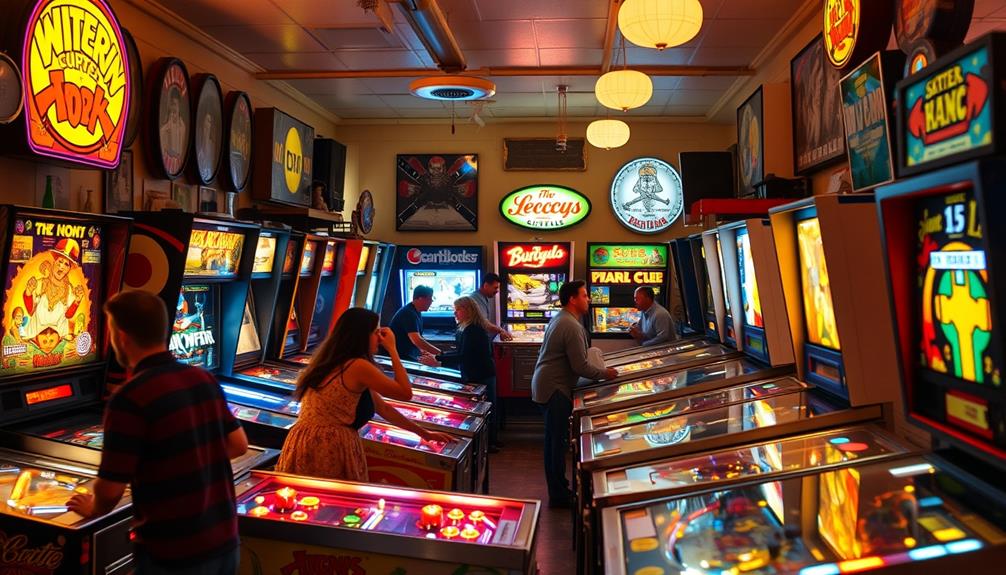
Growing enthusiasm for pinball in the 2000s reignited interest in its rich cultural history. You mightn't realize it, but pinball machines have been a significant part of American entertainment since the 1930s and 1940s, enchanting audiences in bars, candy stores, and amusement centers.
The introduction of the flipper in 1947 transformed the game from one based on chance to one emphasizing skill-based gameplay, enhancing its cultural appeal.
However, pinball faced political opposition during the early 1940s, particularly in New York City, where it was banned due to concerns about gambling and its effect on youth. The repeal of this ban in 1976 marked a turning point, recognizing skill-based gameplay and fostering a cultural acceptance that led to a resurgence in popularity.
Today, you can see the cultural significance of pinball reflected in modern enthusiasts who celebrate its nostalgia and mechanical gameplay.
Events and communities dedicated to pinball have emerged, showcasing its lasting legacy and influence in the gaming world. Pinball isn't just a game; it's a reflection of our shared history and a tribute to the joy it brings across generations.
Future Trends in Pinball
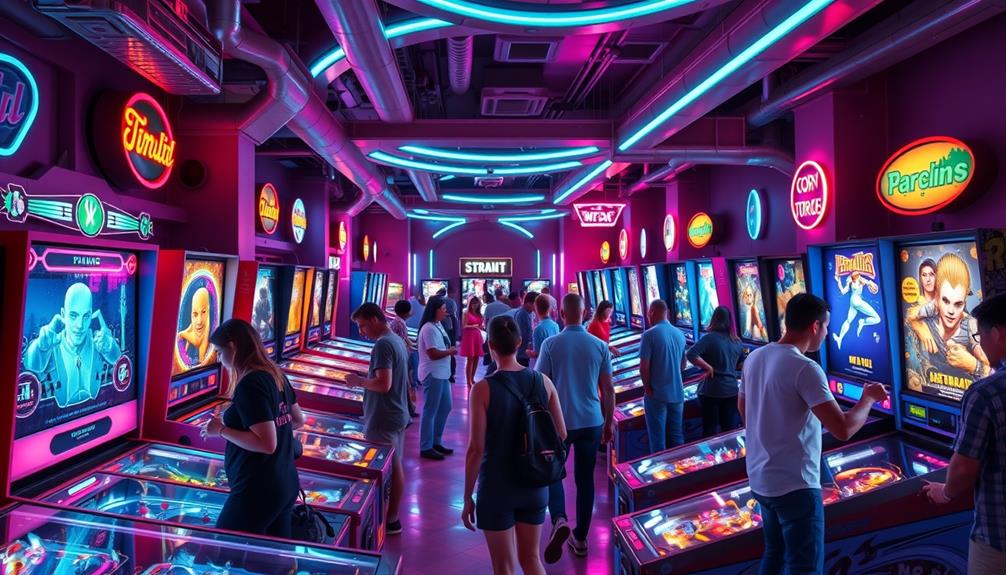
A vibrant future awaits pinball as it continues to evolve and capture the imaginations of players. The resurgence of interest in this classic game has led to exciting new releases and modern designs that integrate advanced technology. You'll find machines featuring LED lighting and interactive elements that enhance gameplay.
Expect to see trends like:
- Nostalgia-driven retro machines appealing to both new players and seasoned enthusiasts.
- Competitive pinball events gaining traction, creating a sense of community and attracting diverse audiences.
- Innovative collaborations with popular franchises, keeping the game fresh and relevant in today's digital landscape.
Independent manufacturers like Jersey Jack Pinball and Spooky Pinball are shaking things up by offering unique themes and gameplay experiences.
Their contributions guarantee that pinball stays in tune with contemporary tastes while still embracing its rich history.
As the community grows and evolves, you'll witness an exciting blend of tradition and innovation.
Frequently Asked Questions
Were Pinball Machines Popular in the 80S?
You might think pinball machines were popular in the 80s, but their appeal declined markedly. As video games surged, fewer players chose pinball, leading to a drastic drop in machine production and operational availability.
Why Were Pinball Machines Banned in the 1970S?
Imagine a smoky backroom, where pinball machines are deemed gambling threats. In the 1970s, bans rooted in moral panic persisted, but you'd soon witness a revolt, as skillful play reclaimed their rightful place in society.
When Was the Golden Age of Pinball?
The Golden Age of pinball happened in the late 1970s and early 1980s. You'd find innovative designs, engaging gameplay, and a vibrant culture, making it a thrilling time for players and collectors alike.
Was Pinball Popular in the 1970S?
You might see pinball machines as vibrant stars in a gaming galaxy, shining brightly in the 1970s. They captivated players with innovative designs and solid-state tech, creating a thrilling atmosphere in bars and arcades everywhere.
Conclusion
In the world of pinball, you'll find a journey filled with innovation, nostalgia, and community. From the bustling arcades of the Golden Age to the digital age's challenges, pinball has bounced back with flair. It's a blend of past charm and future potential, inviting players to flip, spin, and score. As you explore this vibrant scene, remember: pinball's not just a game; it's a timeless experience, a cultural icon, and a community of passionate players.
